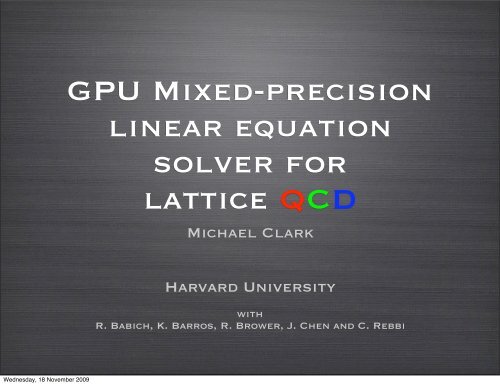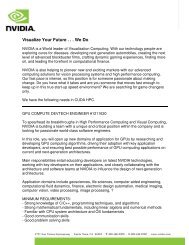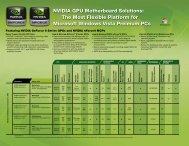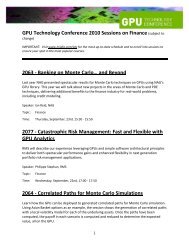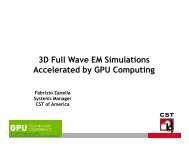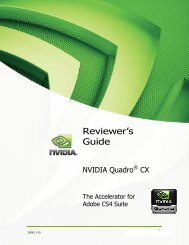Michael Clark Harvard University
Michael Clark Harvard University
Michael Clark Harvard University
Create successful ePaper yourself
Turn your PDF publications into a flip-book with our unique Google optimized e-Paper software.
Wednesday, 18 November 2009<br />
GPU Mixed-precision<br />
linear equation<br />
solver for<br />
lattice QCD<br />
<strong>Michael</strong> <strong>Clark</strong><br />
<strong>Harvard</strong> <strong>University</strong><br />
with<br />
R. Babich, K. Barros, R. Brower, J. Chen and C. Rebbi
Wednesday, 18 November 2009
Quantum<br />
ChromoDynamics<br />
• QCD is the theory of the strong force that binds nucleons<br />
• Impose local SU(3) symmetry on vacuum<br />
• Color charge analogous to electric charge of EM<br />
tice QCD path integral<br />
N f<br />
• Lagrangian of the theory very simple to write down<br />
〈Ω〉 = 1<br />
Z<br />
iγμ LQCD = ψi ( (Dμ)ij - mδij)<br />
ψj- Gμν aGμν a<br />
• Path integral formulation<br />
Introduction<br />
2 • Infinite dimensional integral<br />
(N f<br />
�<br />
〈Ω〉 = 1<br />
Z<br />
[dU]e −Sg(U) [det M(U)] α Ω(U)<br />
�<br />
[dU]e − � d 4 xL(U) Ω(U)<br />
4 ) for Wilson (staggered) fermions, M = M † M<br />
• Theory is strictly non-perturbative at low energies<br />
− 10 9 degrees of freedom ⇒ Monte Carlo integration<br />
Wednesday, 18 November 2009
D path integral<br />
〈Ω〉 = 1<br />
Z<br />
Lattice QCD<br />
• Lattice QCD path integral<br />
〈Ω〉 = 1<br />
Z<br />
• Only known non-perturbative method is lattice QCD<br />
�<br />
Introduction<br />
• Discretize and finitize spacetime<br />
α = N f<br />
2 (N f<br />
Introduction<br />
• 4d periodic spacetime lattice (e.g., 128 4 x 3 x 4 dof)<br />
• 108-109 dimension integral => Monte Carlo integration<br />
importance sampling<br />
• Interpret as a Boltzmann weight<br />
• Use importance sampling 〈Ω〉 ≈ 1<br />
�<br />
[dU]e<br />
Z<br />
N�<br />
Ω(Ui)<br />
− � d4xL(U) • LatticeΩ(U) QCD path integral<br />
�<br />
〈Ω〉 = 1<br />
�<br />
〈Ω〉 = 1<br />
Z<br />
[dU]e −Sg(U) [det M(U)] α Ω(U)<br />
• Ab initio calculation to verify QCD is theory of strong force<br />
�<br />
[dU]e − � d 4 xL(U) Ω(U)<br />
4 ) for Wilson (staggered) fermions, M = M † M<br />
• 10 8 − 10 9 degrees of freedom ⇒ Monte Carlo integration<br />
[dU]e −Sg(U) [det M(U)] α Ω(U)<br />
• Interpret e −Sg det M α as a Boltzmann weight, and use<br />
) for Wilson (staggered) fermions, M = M i=1<br />
• Lattice QCD is a 2 step process<br />
• Generate (gluon field) configurations with weight<br />
3<br />
• Calculate mean observables<br />
† M<br />
egrees of freedom ⇒ Monte Carlo integration<br />
Sg det Mα [dU]e<br />
Z<br />
as a Boltzmann weight, and use<br />
sampling<br />
−Sg(U)<br />
[det M(U)]<br />
〈Ω〉 = 1<br />
�<br />
Z<br />
α = Nf ) for Wilson (staggered) fermions<br />
Wednesday, 18 November 2009<br />
2 (N f<br />
4<br />
〈Ω〉 = N<br />
1<br />
Introduction<br />
[dU]e − � d 4 xL(U) Ω(U<br />
〈Ω〉 ≈ 1 N �• 10<br />
Ω(U )<br />
8 − 109 degrees of freedom ⇒ Monte Carlo
Wednesday, 18 November 2009<br />
topology<br />
string<br />
Visualisation<br />
coutesty of<br />
M. Di Pierro
Wednesday, 18 November 2009
Wednesday, 18 November 2009
Wednesday, 18 November 2009
Wednesday, 18 November 2009<br />
Lattice QCD<br />
• Many computational / algorithmic challenges, e.g.:<br />
• Discretization<br />
• Monte Carlo integration<br />
• Molecular dynamics<br />
• Matrix function evaluation<br />
• Sign problem<br />
• Solving systems of linear equations<br />
• Grand challenge problem<br />
• Peta/Exaflops required<br />
• GPUs as a means of getting there?
Wednesday, 18 November 2009
GPU Hardware<br />
GTX 280<br />
Flops: single ~1 Tflop, double ~80 Gflops<br />
Memory 1GB, Bandwidth 141 GBs -1<br />
Tesla 1070<br />
Flops: single ~4 Tflops, double ~320 Gflops<br />
Memory 16GB, Bandwidth 408 GBs -1<br />
Wednesday, 18 November 2009<br />
230 Watts, $350<br />
900 Watts, $8000<br />
Tesla 1060<br />
Flops: single ~1 Tflop, double ~80 Gflops<br />
Memory 4GB, Bandwidth 102 GBs -1<br />
230 Watts, $1200
Wednesday, 18 November 2009<br />
Solving Large Systems<br />
of Equations<br />
• Assumptions:<br />
• A is sparse (O(N) non-zeros)<br />
• N large (10 7 -10 10 )<br />
Ax = b<br />
• In general the explicit matrix inverse is never needed<br />
• Only interested in solution x to some precision ε<br />
• Gaussian elimination O(N 3 )<br />
• Indirect iterative solvers scale as O(N) - O(N 2 )
Iterative Linear Solvers<br />
• Many possible iterative solvers<br />
• Optimal method will depend on<br />
• Nature of matrix: SPD, HPD, RPD, indefinite etc.<br />
• Nature of hardware: serial, MP, geometry, comms overhead etc.<br />
• E.g.,<br />
Wednesday, 18 November 2009<br />
• Jacobi<br />
• Gauss-Seidel<br />
• Multigrid<br />
• Krylov subspace methods
Wednesday, 18 November 2009<br />
Krylov Solvers<br />
• e.g., Conjugate Gradients<br />
Dominant cost<br />
is mat-vec<br />
• Krylov solvers can all be decomposed into simple linalg kernels<br />
• Matrix-vector product is inherently parallel<br />
• Ideal for GPU implementation<br />
• Just need a fast mat-vec?<br />
while (|rk|> ε) {<br />
βk = (rk,rk)/(rk-1,rk-1)<br />
}<br />
pk+1 = rk - βkpk<br />
α = (rk,rk)/(pk+1,Apk+1)<br />
rk+1 = rk - αApk+1<br />
xk+1 = xk + αpk+1<br />
k = k+1
Wednesday, 18 November 2009<br />
Dirac operator of QCD<br />
• From the QCD Lagrangian<br />
iγμ LQCD = ψi ( (Dμ)ij - mδij)<br />
ψj- Gμν aGμν a
Wednesday, 18 November 2009<br />
Dirac operator of QCD<br />
• The Dirac operator represent quark interactions<br />
iγ μ (Dμ)ij - mδij<br />
• Essentially a PDE with background SU(3) field<br />
• Many discretization strategies<br />
• Wilson discretization<br />
• others: Overlap, staggered etc.
Wednesday, 18 November 2009<br />
Wilson Matrix of QCD<br />
iγ μ (Dμ)ij - mδij
Wednesday, 18 November 2009<br />
Wilson Matrix of QCD<br />
Σμ ((1-γ μ )Ux,y μ δx+μ,y + (1+γ μ )Uy,x μ† δx-μ,y) + (4+m)δx,y
Wednesday, 18 November 2009<br />
Wilson Matrix of QCD<br />
Σμ ((1-γ μ )Ux,y μ δx+μ,y + (1+γ μ )Uy,x μ† δx-μ,y) + (4+m)δx,y<br />
• U is discretized gauge field (SU(3))<br />
• γ are Dirac matrices (4x4)<br />
• 8 off-diagonals in spacetime, mass on diagonal<br />
• Off-diagonals are 12x12 matrices (SU(3) x γ)<br />
• Each point in spacetime referred to as a spinor<br />
• Matrix not Hermitian but γ5-Hermitian<br />
• Block “Laplace” in 4 dimensions
Wednesday, 18 November 2009
Wednesday, 18 November 2009<br />
Wilson Matrix of QCD<br />
Σμ ((1-γ μ )Ux,y μ δx+μ,y + (1+γ μ )Uy,x μ† δx-μ,y) + (4+m)δx,y<br />
• Quark physics requires solution A(U)x=b<br />
• Krylov solvers standard method<br />
• Condition number given by ~(quark mass) -1<br />
• Up / down quark masses are light<br />
• Computationally expensive
Wednesday, 18 November 2009<br />
SpMV I<br />
• Standard matrix-vector libraries available (Bell and Garland)<br />
• Pack your matrix, call library function, unpack<br />
• Ignorant of structure and symmetries of problem<br />
• Bad for storage (double storage of matrix elements)<br />
• Bad for operation count (200% flops)<br />
• Bad for compute intensity (1:2 flop / byte ratio)<br />
• Consider single precision and single GPU only
!"#$%&'<br />
$"<br />
$!<br />
#"<br />
#!<br />
"<br />
!<br />
Wednesday, 18 November 2009<br />
%&& %'()*+,-.-/0 %'()*12,34/0 567<br />
(a) Single Precision<br />
Bell and Garland (NVIDIA) 2009<br />
'(( ')*+,-./0/12 ')*+,34.5612 789
Wednesday, 18 November 2009<br />
SpMV II<br />
• Wilson matrix is just a block stencil<br />
• Much better to consider matrix as a nearest neighbor gather operation<br />
• Assign thread to each spacetime point -> massive parallelism<br />
• Avoids double storage of matrix elements (Hermiticity)<br />
• Repetitive structure means no explicit indexing required<br />
• Can order data optimally for any given hardware<br />
• Reorder field elements for coalescing<br />
• Large reduction in flops and required bandwidth<br />
• 1:1 flop / bandwidth ratio<br />
• Better, but still very bandwidth limited
Wednesday, 18 November 2009<br />
SpMV III<br />
• Wilson matrix is a matrix of matrices<br />
• SU(3) matrices are all unitary complex matrices with det = 1<br />
• 18 numbers with 4 orthogonality and 6 normality constraints<br />
• 12 number parameterization: bytes 80%, flops 128%<br />
(<br />
a1 a2 a3<br />
)<br />
a1 a2 a3<br />
b1 b2 b3<br />
c = (axb)*<br />
b1 b2 b3<br />
c1 c2 c3<br />
• Minimal 8 number parameterization: bytes 71%, flops 163%<br />
a1 a2 a3<br />
(<br />
b1 b2 b3<br />
( ) arg(a1) arg(c1) Re(a2) Im(a2)<br />
)<br />
Re(a3) Im(a3) Re(b1) Im(b1)<br />
c1 c2 c3<br />
• Obtain a1 and c1 from normality<br />
( )<br />
• Reconstruct b2, b3, c2, c3 from SU(2) rotation
Gflops<br />
140<br />
120<br />
100<br />
80<br />
Wednesday, 18 November 2009<br />
12 reconstruct<br />
8 reconstruct<br />
0 32 64 96 128<br />
Temporal Extent<br />
Wilson Matrix-Vector Performance<br />
Single Precision (V=24 3 xT)
ions<br />
SpMV IV<br />
CD software to use the DeGrand-Rossi basis<br />
ch appear in the Wilson-Dirac operator offre<br />
given by<br />
⎞<br />
±i • Can impose similarity transforms to improve sparsity<br />
0 ⎟<br />
0 ⎠ • Can globally change Dirac matrix basis<br />
1<br />
P ±2 We must always load all spinor components regardless of the dimension or<br />
direction. An alternative basis is the UKQCD basis, in which the projectors<br />
have the form<br />
⎛<br />
⎞<br />
1 0 0 ∓1<br />
⎜<br />
= ⎜ 0 1 ±1 0 ⎟<br />
⎝<br />
P<br />
0 ±1 1 0 ⎠<br />
∓1 0 0 1<br />
±1 ⎛<br />
⎞<br />
1 0 0 ±i<br />
⎜<br />
= ⎜ 0 1 ±i 0 ⎟<br />
⎝ 0 ∓i 1 0 ⎠<br />
∓i 0 0 1<br />
P ±2 ⎛<br />
⎞<br />
1 0 0 ±1<br />
⎜<br />
= ⎜ 0 1 ∓1 0 ⎟<br />
⎝ 0 ∓1 1 0 ⎠<br />
±1 0 0 1<br />
0<br />
i<br />
0<br />
1<br />
⎞<br />
⎟<br />
⎠ P ±4 =<br />
⎛<br />
⎜<br />
⎝<br />
P ±3 =<br />
1<br />
0<br />
±1<br />
⎞<br />
0 ±1 0<br />
1 0 ±1 ⎟<br />
0 1 0 ⎠<br />
0 ±1 0 1<br />
.<br />
P ±3 ⎛<br />
1 0<br />
⎜<br />
= ⎜ 0 1<br />
⎝ ∓i 0<br />
±i<br />
0<br />
1<br />
0<br />
∓i<br />
0<br />
0 ±i 0 1<br />
components regardless of the dimension or<br />
s the UKQCD basis, in which the projectors<br />
• Impose local color transformation (gauge transformation)<br />
⎞<br />
±i • SU(3) field = unit matrix in temporal direction<br />
0 ⎟<br />
0 ⎠<br />
• Must calculate this transformation (done once only)<br />
1<br />
• In total 33% reduction in bandwidth<br />
P ±2 ⎛<br />
⎞<br />
1 0 0 ±1<br />
⎜<br />
= ⎜ 0 1 ∓1 0 ⎟<br />
⎝ 0 ∓1 1 0 ⎠<br />
±1 0 0 1<br />
⎛<br />
2<br />
⎜<br />
+4<br />
= ⎜ 0<br />
⎝ 0<br />
0<br />
2<br />
0<br />
⎞<br />
0 0<br />
0 0 ⎟<br />
0 0 ⎠<br />
0 0 0 0<br />
P −4 ⎛<br />
⎞<br />
0 0 0 0<br />
⎜<br />
= ⎜ 0 0 0 0 ⎟<br />
⎝ 0 0 2 0 ⎠<br />
0 0 0 2<br />
.<br />
The advantage of this approach is that in the temporal dimension we need<br />
only load the upper (lower) spin components for the backwards (forwards)<br />
gather. This halves the amount of bandwidth required to perform the temporal<br />
gather, and so increases the kernel’s performance.<br />
References<br />
[1] G. I. Egri, Z. Fodor, C. Hoelbling, S. D. Katz, D. Nogradi and K. K. Szabo,<br />
“Lattice QCD as a video game,” Comput. Phys. Commun. 177<br />
(2007) 631 [arXiv:hep-lat/0611022].<br />
18<br />
is that in the temporal dimension we need<br />
Wednesday, 18 November 2009<br />
⎛<br />
⎜<br />
⎝<br />
1 0 ±i 0<br />
0 1 0 ∓i<br />
∓i 0 1 0<br />
0 ±i 0 1<br />
⎞<br />
⎞<br />
⎟<br />
⎠ P +4 =<br />
⎟<br />
⎠ P ±4 =<br />
⎛<br />
⎜<br />
⎝<br />
⎛<br />
⎜<br />
⎝<br />
2 0 0 0<br />
0 2 0 0<br />
0 0 0 0<br />
0 0 0 0<br />
1 0 ±1 0<br />
0 1 0 ±1<br />
±1 0 1 0<br />
0 ±1 0 1<br />
⎞<br />
⎟<br />
⎠ P −4 =<br />
⎛<br />
⎜<br />
⎝<br />
⎞<br />
⎟<br />
⎠ .<br />
0 0 0 0<br />
0 0 0 0<br />
0 0 2 0<br />
0 0 0 2<br />
⎞<br />
⎟<br />
⎠ .
Gflops<br />
140<br />
120<br />
100<br />
80<br />
Wednesday, 18 November 2009<br />
12 reconstruct<br />
12 reconstruct, GF<br />
8 reconstruct<br />
8 reconstruct, GF<br />
0 32 64 96 128<br />
Temporal Extent<br />
Wilson Matrix-Vector Performance<br />
Single Precision (V=24 3 xT)
Gflops<br />
140<br />
120<br />
100<br />
Wednesday, 18 November 2009<br />
12 reconstruct<br />
12 reconstruct, GF<br />
8 reconstruct<br />
8 reconstruct, GF<br />
80<br />
0 32 64<br />
Temporal Extent<br />
96 128<br />
Wilson Matrix-Vector Performance<br />
Single Precision, padded (V=24 3 xT)
Gflops<br />
40<br />
35<br />
30<br />
25<br />
20<br />
15<br />
10<br />
Wednesday, 18 November 2009<br />
12 reconstruct, GF<br />
8 reconstruct, GF<br />
0 20 40 60 80 100<br />
Temporal Extent<br />
Wilson Matrix-Vector Performance<br />
Double Precision (V = 24 3 xT)
Wednesday, 18 November 2009<br />
Krylov Solver<br />
Implementation<br />
• Complete solver must be on GPU<br />
• Transfer b to GPU<br />
• Solve Ax=b<br />
• Transfer x to CPU<br />
• Besides matrix-vector, require BLAS level 1 type operations<br />
• AXPY operations: b += ax<br />
• NORM operations: c = (b,b)<br />
• CUBLAS library available<br />
• Better to fuse kernels to minimize bandwidth<br />
• e.g., AXPY_NORM
Gflops<br />
120<br />
110<br />
100<br />
90<br />
Wednesday, 18 November 2009<br />
Performance of Dirac-Wilson Linear Equation Solver<br />
Wilson matrix-vector<br />
BiCGstab<br />
CG<br />
V = 24 3<br />
80<br />
0 20 40 60 80 100<br />
Temporal Extent<br />
Wilson Inverter Performance<br />
Single Precision (12 reconstruct, V=24 3 xT)
Mixed-Precision Solvers<br />
• Require solver tolerance beyond limit of single precision<br />
• Double precision is at least x2 slower<br />
• Use defect-correction (iterative refinement)<br />
Double precision<br />
mat-vec and<br />
accumulate<br />
Wednesday, 18 November 2009<br />
while (|rk|> ε) {<br />
}<br />
rk = b - Axk<br />
pk = A -1 rk<br />
xk+1 = xk + pk<br />
• Double precision done can be done on CPU or GPU<br />
• Can always check GPU gets correct answer<br />
Inner single<br />
precision solve<br />
• Disadvantage is each new single precision solve is a restart
Wednesday, 18 November 2009<br />
Mixed-Precision Solvers<br />
• Want to use mixed precision, but avoid restart penalty<br />
• Reliable Updates (Sleijpen and Van der Worst 1996)<br />
• Iterated residual diverges from true residual<br />
• Occasionally replace iterated residual with true residual<br />
• Also use second accumulator for solution vector<br />
if (|rk|< δ|b|) {<br />
rk = b - Axk<br />
b = rk<br />
y = y + xk<br />
xk = 0<br />
• Idea: Use high precision for reliable update<br />
}
Number of iterations<br />
3000<br />
2500<br />
2000<br />
1500<br />
1000<br />
500<br />
Wednesday, 18 November 2009<br />
Increasing conditioner number<br />
0<br />
-0.42 -0.415 -0.41 -0.405 -0.4<br />
mass<br />
Wilson Inverter Iterations<br />
(ε=10 -12 , V=24 3 x64, BiCGstab)<br />
Double<br />
Reliable<br />
Defect
Time (seconds)<br />
10000<br />
8000<br />
6000<br />
4000<br />
2000<br />
0<br />
Wednesday, 18 November 2009<br />
Increasing conditioner number<br />
Double<br />
Single<br />
m crit<br />
-0.42 -0.41 -0.4<br />
mass<br />
Wilson Inverter Time to Solution<br />
(ε=10 -8 , V=32 3 x96, BiCGstab)
Wednesday, 18 November 2009<br />
Half Precision<br />
• Single-precision can be used to find double-precision result<br />
• GPU kernel is still bandwidth bound<br />
• Use half precision for inner solve?<br />
• Performance increases > 210 Gflops<br />
Gflops<br />
240<br />
200<br />
160<br />
120<br />
Single<br />
Half<br />
0 32 64 96 128<br />
Temporal Extent
Number of iterations<br />
3000<br />
2500<br />
2000<br />
1500<br />
1000<br />
500<br />
Wednesday, 18 November 2009<br />
Increasing conditioner number<br />
0<br />
-0.42 -0.415 -0.41 -0.405 -0.4<br />
mass<br />
Wilson Inverter Iterations<br />
(ε=10 -12 , V=24 3 x64, BiCGstab)<br />
Double<br />
Reliable S<br />
Defect S<br />
Reliable H<br />
Defect H
Time to solution / s<br />
300<br />
250<br />
200<br />
150<br />
100<br />
50<br />
Wednesday, 18 November 2009<br />
Double<br />
Single 8<br />
Half 12<br />
Increasing conditioner number<br />
0<br />
-0.42 -0.415 -0.41 -0.405 -0.4<br />
mass<br />
Wilson Inverter Time to Solution<br />
(ε=10 -8 , V=32 3 x96, BiCGstab)<br />
5<br />
4<br />
3<br />
Speedup<br />
2<br />
1<br />
0
Wednesday, 18 November 2009<br />
How Fast is<br />
Fast?
Wednesday, 18 November 2009<br />
Performance Per MFLOP<br />
=
Wednesday, 18 November 2009<br />
Performance Per Watt<br />
=
Wednesday, 18 November 2009<br />
Performance Per $<br />
=
Wednesday, 18 November 2009<br />
Case Study: Jlab<br />
• Require 150 Gflops sustained performance per job<br />
• Nehalem-Infiniband cluster<br />
• 8 nodes<br />
• $0.20 per Mflop<br />
• GPU solution<br />
• 4x GTX 285 per Nehalem box<br />
• Trivial parallelism<br />
• $0.02 per Mflop<br />
• 30 Tflops sustained
Wednesday, 18 November 2009<br />
• Need to scale to many GPUs<br />
• Size of problem<br />
• Raw flops<br />
• Preliminary implementation<br />
Multi-GPU<br />
• No overlap of comms and compute<br />
• 1 MPI process per GPU<br />
• 90% efficiency on 4 GPUs (S1070)<br />
• Many GPUs challenging but possible<br />
• 1 GPU per PCIe slot<br />
• New algorithms
Wednesday, 18 November 2009<br />
• Need to scale to many GPUs<br />
• Size of problem<br />
• Raw flops<br />
• Preliminary implementation<br />
Multi-GPU<br />
• No overlap of comms and compute<br />
• 1 MPI process per GPU<br />
• 90% efficiency on 4 GPUs (S1070)<br />
• Many GPUs challenging but possible<br />
• 1 GPU per PCIe slot<br />
0<br />
• New algorithms 1 2 3 4<br />
Number of GPUs<br />
Parallel Efficiency<br />
1<br />
0.8<br />
0.6<br />
0.4<br />
0.2<br />
V = 8 3 128<br />
V = 32 4
Matrix-vector products<br />
20000<br />
15000<br />
10000<br />
5000<br />
0<br />
Wednesday, 18 November 2009<br />
CG<br />
MG-GCR<br />
Increasing conditioner number<br />
-0.42 -0.41 -0.4<br />
mass<br />
Iterations Until convergence: MG vs CG<br />
(ε=10 -8 , V=32 3 x96)
Wednesday, 18 November 2009<br />
Multigrid on GPU<br />
Fine Grid<br />
Intermediate Grid<br />
Coarse Grid<br />
• Poor mapping of multigrid onto MPP architectures<br />
• Heterogenous Algorithm => Heterogenous Architecture<br />
• Fine and intermediate grid operations performed on GPU<br />
• Coarse grid operators performed on CPU<br />
GPU GPU GPU GPU<br />
CPU<br />
• GPU + CPU combination ideal for multigrid
Wednesday, 18 November 2009<br />
Conclusions<br />
• Fantastic algorithmic performance obtained on today GPUs<br />
• Flops per Watt, Flops per $<br />
• Game changer for QCD<br />
• Fermi expected to be even more so<br />
• Some work required to get best performance<br />
• Standard libraries were not an option<br />
• Knowledge of the problem required<br />
• Algorithm design critical component<br />
• Flops are free, bandwidth is expensive<br />
• Mixed-precision methods
Wednesday, 18 November 2009<br />
More Info...<br />
• mikec@seas.harvard.edu<br />
• Source code available<br />
http://lattice.bu.edu/quda<br />
• Paper online as of today<br />
http://arxiv.org/abs/0911.3191


